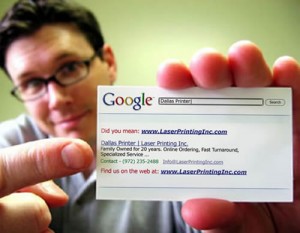Due diligence refers to the exercise of reasonable care prior to committing to the acquisition or...
Making Business Cards Work For Your Business
 Business cards are an important element of your visual identity but they can be an important part of your wider business strategy as well.
Business cards are an important element of your visual identity but they can be an important part of your wider business strategy as well.
Who should have a business card?
Make sure everyone in your company does a better job of serving your customers by giving them their own business cards, from the owner and managers right down to the front line team. Anyone who has any contact with your customers, even the delivery team, represents your company and influences your clients to buy more from you.
It gives the team member a good reputation to live up to. It lets them know that you see them all as important and capable of assisting the company increase services and product sales to all present and future clients.
It is also a way of communicating to your clients that their satisfaction matters to you; that you want them to have an accountable person, someone in the company they know personally, who will be responsible for making sure they get what they paid for.
Designing your card
Avoid the temptation of designing it yourself! We live in a very visual culture so your brand is a vital part of establishing a strong business identity; trust a project that is this important to a professional. Check the work of a few graphic design companies in your area that do this sort of thing and get a fixed price quote.
What should be on the card?
- Company name and logo
- Person’s name – optionally their title
- Address
- Phone number
- Contact email; personal or general
- Website url
- Social media links if you use them - Facebook Fan Page, Twitter etc.
Smart ideas for business cards
- Include a photo. A photo helps people remember who they met; putting names and faces together is often hard to do later on.
- Include a call to action. You can tell people to call a certain number, visit a certain website or entice them with an offer.
- If you are a tradesperson try a picture of past projects on the back. Include photos that show the results of your best work in full colour e.g. a stairwell you installed or a table you made.
- Give the name of the licence you hold to reassure customers up front, and say where people can go (or call) to confirm your identity.
- Quote praise from customers. Testimonials demonstrate your reputation.
- Fridge magnet cards for household maintenance businesses.
- Provide a link to answers to commonly asked questions on your site.
- Essential information e.g. appointment schedule or a map to your place of business.
- A message on the back; brief and provocative or longer. Keep it under 100 words.
- Custom shapes and materials - more expensive but memorable, and works well particularly for use at trade shows and events.
- Create one-off cards for specific events. Cheap business card printing is widely available. If you don’t want to use a designer, some programmes will let you insert your existing brand logo and brand colours. Stick with your brand colours! Include your photo on the front of the card and a headline e.g. “I Look Forward To Meeting You Again At This Event. Look For Me.” Include links to special webpages for the event such as a trade show.
- Get quirky and creative – shards of broken pottery with name and address details for a Greek restaurant; a card that is a small packet of seeds for a plant nursery.
Need some ideas about what is possible - have a look at these
100 (Really) Creative Business Cards

